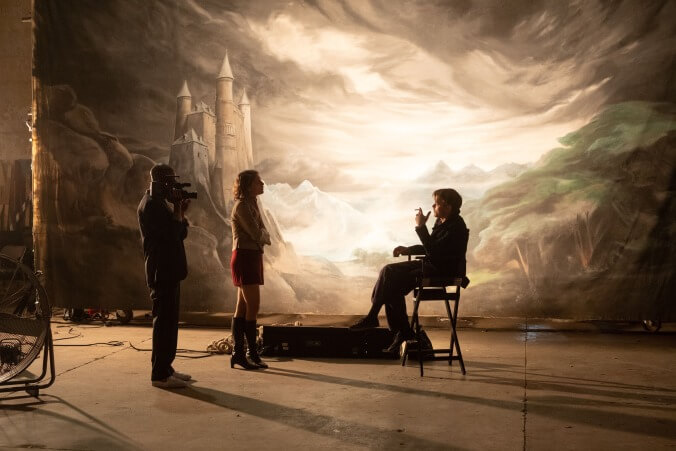The Souvenir: Part II is the rare sequel to improve on its terrific predecessor
Writer-director Joanna Hogg delivers her alter-ego into the light

This review reveals major plot details from The Souvenir.
In British director Joanna Hogg’s autobiographical The Souvenir, film student Julie (Honor Swinton Byrne) fell for (ostensible) foreign service operative and (definite) heroin addict Anthony (Tom Burke). The film ended with his death by overdose, before an unexpected promise in the end credits: “The Souvenir Part II coming soon.” Two years later, that promised continuation has indeed arrived—and it’s looser, wilder, funnier, and almost euphorically uplifting, rocketing at increasing speed towards a new life for its main character and directorial proxy that makes the starting premise look almost irrelevant.
As Part II begins, a shell-shocked Julie is resting at the country house of parents Rosalind (Tilda Swinton) and William (James Spencer Ashworth). (Julie is Hogg’s fictional stand-in, and the actor’s real-life mother, Tilda, stands in for the director’s.) Diffident by default, especially when interrogated by male film school teachers, Julie has retreated into even greater silence and hesitancy than before. She still wants to better understand and unpack the traumatic events she’s just experienced, and asks mutual friends and Anthony’s drug associates questions at awkward moments. But the debut feature film she was struggling to conceive in part one still has to be made, and so Julie’s attention—and the movie’s—increasingly drifts to her work.
In the first film, Julie didn’t enter a soundstage until more than halfway through, almost immediately tripping over a light and infuriating her director of photography in a sequence designed to give anyone who’s ever crewed on a student film painful flashbacks. Per the expected sequel model of “give people what they liked about the first film but more,” The Souvenir Part II’s on- and off-set battles begin earlier and increase in ferocity, in part because of Julie’s own inexperience regarding how a set should run. The Souvenir Part II’s willingness to dive into the granular details of film production and history rivals classics like Day For Night and Irma Vep.
There’s a greater ease of tone and comedy in The Souvenir Part II, attributable to both its own production process—the film was shot after the original was completed, allowing the ensemble to gel and find more space to riff—and to its concept: After being isolated in her relationship, Julie finds her life transformed by the collective nature of filmmaking. She grows along multiple axes, her healing process linked to her increasing technical competence and acumen. By film’s end, she’s directing music videos for a living. This is not an unambiguously positive arc: Hogg made videos and TV for years after graduating in 1986, before finally directing her first feature, Unrelated, in 2007; she has expressed regret at making so much artistically unsatisfying work in the interim. One of the film’s very specific observations is that technical craftsmanship can exist entirely independent of artistic merit.
Hogg contextualizes Julie’s project against those of two fellow students, both introduced in the first film and granted substantially more screen time and dialogue here. Heard heatedly extolling the virtues of the then-popular, commercially-friendly French “Cinéma du look” movement, as exemplified by Jean-Jacques Beineix’s 1981 Diva, Garance (Ariane Labed) is now working on a sci-fi film. Meanwhile, hilariously bratty Patrick (Richard Ayoade)—who decried the lack of any significant British musicals in part one—is working on a glossy black-and-white feature to address that paucity. Both Ayoade’s character and his film’s tumultuous production (a brief excerpt is seen) are clearly modeled on the chaotic making of 1986’s Absolute Beginners, during which Hogg’s contemporary, Julien Temple, was banned from the editing room after running over budget before production had even started.
Recalling his struggle to get Beginners funded, Temple noted that his proposed artifice was rejected at a time when “Mike Leigh and Ken Loach were the cutting edge of cinema” in the U.K. If The Souvenir Part II (gently) roasts his onscreen stand-in’s arrogance, Hogg’s approach finds a middle ground between doctrinaire, politically-minded realism and absolute artifice. Hogg writes frameworks for scenes and parts of dialogue but allows plenty of room for improvisation, which shows in the freshness of the interactions. When Julie does complete her graduate film, that’s not quite what we see: Hogg’s climax is an extravagant musical of her own, clearly more lavish than achievable with Julie’s resources, its sets directly modeled on Powell & Pressburger touchstones including A Matter Of Life And Death and The Red Shoes in a boldly colored, hallucinatory reconstruction of the first film’s events.
That brings Part II full circle to one of the first conversations Julie and Anthony had in the original, where he castigated her aspirations to make a film plotted from the lives of real people rather than finding her own truths and stories, citing Powell & Pressburger as an admirable model. Just as Julie radically adjusts her artistic goals, The Souvenir Part II changes its shape as necessary to suit each moment of her growth. Months are elided at an increasing clip: Only with footage of the Berlin Wall falling does it become clear just how much time has passed since the story began in the mid-’80s—just how far Julie’s come since then and how thoroughly absorbed in a now-concrete future she is.
By the film’s end, Julie has taken everything she can from the formative heartbreak of The Souvenir, transforming it into art and a sustainable career with ramifications beyond its point of traumatic origin. The twin Souvenirs’ own journey from claustrophobic tragedy to vibrant social comedy is no less exhilarating, or moving, than their heroine’s. Art and life speedily evolve as one, the possibility of renewal and change demonstrated in practice.